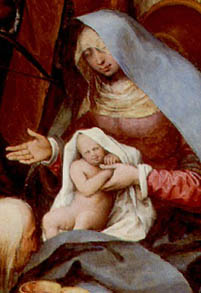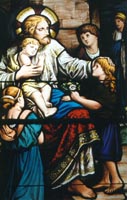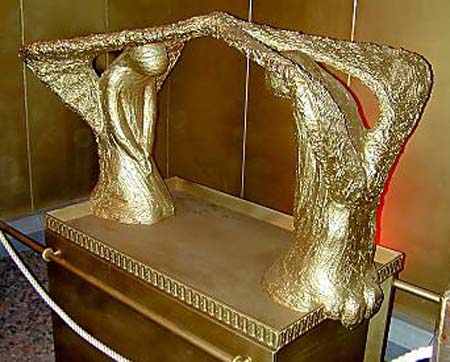Blog Archive for 2/29/04 - 3/6/04
Reflection: What was Jesus' Actual Message?
Part 1 of series: "What Was the Message of Jesus?"
Posted at 10:45 p.m. on Saturday, March 6, 2004
With The Passion of the Christ so much in our minds these days, I had planned to do some blogging on the question: Why was Jesus crucified? But as I pondered this question, I realized that my answer would only make sense in light of a prior answer to another question: What was Jesus' actual message? So I'll get to the reason for Jesus' crucifixion in a while. But first I need to lay a foundation for that reason by dealing with Jesus' message. This isn't quite so easy as it might at first seem. Yet the effort to grasp Jesus' actual message pays rich dividends, because it makes sense, not only of his life and ministry, but of his death and resurrection.
| If you were to ask the average person what Jesus' preached - even the average Christian - you'd no doubt hear something about love: "Jesus taught about love. He said we should all love each other." This perception of Jesus' teaching isn't wrong, let me hasten to add. Jesus did talk quite a bit about love. In fact he said that loving God is the greatest commandment and loving our neighbors is the runner up (Mark 12:29-31). So, to be sure, love figured prominently in the message of Jesus. |  |
But love was not the core of his proclamation. And, to be sure, his preaching about love didn't get Jesus crucified. Neither the Romans nor the Jewish authorities would have been particularly bothered by a Jewish prophet who ran around telling people to love God and people. Quite a few Jews would have been distressed over the thought of having to love their enemies, however. But the Romans - the obvious enemies -- wouldn't have crucified someone whose main crime was telling Jews to love them and turn the other cheek! The core of Jesus' message must have been more contentious, indeed, more scandalous, than a call to love.
It's common for people to reduce the message of Jesus into something all to simple and, I might add, all too similar to the biases of whoever is doing the reducing. You'll see this in many of the contemporary "scholarly" attempts to summarize the message of Jesus. The infamous Jesus Seminar, by the time it stones Jesus to death with its red, pink, grey, and black beads, ends up with a sage who speaks in esoteric riddles, hardly someone who would be put to death as a threat to Roman order in Judea.
 |
It's common for people to reduce the message of Jesus into something all to simple and, I might add, all too similar to the biases of whoever is doing the reducing. You'll see this in many of the contemporary "scholarly" attempts to summarize the message of Jesus. The infamous Jesus Seminar, by the time it stones Jesus to death with its red, pink, grey, and black beads, ends up with a sage who speaks in esoteric riddles, hardly someone who would be put to death as a threat to Roman order in Judea. |
Whatever Jesus preached, it got people excited. Even the demons were riled up. And Jesus' message angered most of the religious leaders he encountered. In the end, it got him killed on a Roman cross. So what exactly was this inspiring, challenging, goading, and apparently subversive message of Jesus all about?
I'll begin to answer this question in my next post.
Reflection: When Religious Tolerance is Intolerant
Posted at 10:00 p.m. on Friday, March 5, 2004
Indonesia is currently considering legislation that would severely limit Christian expression in this country. Ironically, the bill that would curtail free exercise of religion is called the Religious Tolerance Bill, according to a story from CNSNews.com. Among the restrictions of this bill, tight limits would be placed on the building of churches, evangelism would be prohibited, and it would be illegal for people to convert from one religion to another.
I think it's essential for Christians to understand what's really going on here and the implications. Some of what's behind this Indonesian bill may be a surprise to many of us Western Christians.
| The impetus behind the Religious Tolerance Bill is none other than Muslim fundamentalism. "Muslim fundamentalism in Indonesia?" you may wonder. Yes, indeed, and growing in its influence on a daily basis. |  |
Map from Simple Maps |
You may not know that Indonesia has the largest population of Muslims of any country in the world. We who tend to associate Islam with the Middle East often overlook the fact that there are more Muslims in South Central and South East Asia than in the Middle East itself, the birthplace of Islam. In fact there almost ten times as many Muslims in Indonesia as in Saudi Arabia. (You might also be interested to know that though Islam continues to grow at a steady pace in Asia, its growth rate in Europe is more than ten times the Asian rate. For the data, see islamicweb.com.) So the story about the Religious Tolerance Bill in Indonesia helps us to see Islam in clearer, international perspective.
Historically, Muslims in Indonesia have been tolerant of Christians. But in this country, as in many throughout the world, Islamic fundamentalists are pressing their agenda, insisting, among other things, that the national law conform to Islamic law (shari'a). At the same time, Christians are experiencing a rise of persecution from radical Muslim groups. Many Christians have been victims of violence and many churches have been forced to close.
Ever since the tragic nightclub bombing in Bali, Indonesia on October 12, 2002, we have been much more aware of the presence of Islamic terrorists in Indonesia. Just yesterday, in fact, an Indonesian man was sentenced to nine years in prison for withholding information about the perpetrators of the bombing, who, most experts believe, are part of the Indonesian branch of al-Qaeda.
What difference does all of this make to us? A lot, I think. For example:
· We need to pray for the leaders of Indonesia to reject the so-called Religious Tolerance Bill.
· We must pray for Christians in Indonesia, for safety and for steadfastness.
· We must pray for the moderate Muslims in Indonesia, that they will withstand pressure from the radicals.
· We must learn to see the world clearly, including Islam. For many of us, this begins with the surprise that it's not primarily a Middle Eastern religion.
· We Americans must value our religious freedom and not take it for granted. This means, not only exercising that freedom by living out our faith each day, but also defending our religious freedom from attacks against it, whether these come from academia, Hollywood, the legislature, or the courts.
Reflection: Satan and the Demonic Baby . . . Huh?
Part 4 in the series "Visual Arts in Faith and Worship"
Posted at 10:00 p.m. on Thursday, March 4, 2004
| Perhaps the strangest moment in The Passion of the Christ comes in the midst of Jesus' horrendous flogging. As he is being brutally beaten, the camera scans the crowd, focusing on the figure of Satan, who's standing mysterious in the background. Satan opens his/her robe to reveal a hideous little demonic baby. Weird! |  |
Rosalinda Celentano as Satan in The Passion of the Christ |
Obviously, this is one of those places in The Passion of the Christ where Mel Gibson goes beyond the literal New Testament accounts of Jesus' death. It's also one of the most puzzling moments in the film, by far. I've received many questions about this in the last couple of weeks.
Christianity Today did a great little piece called "What's Up With the Ugly Baby?" The magazine actually contacted Mel Gibson's people, who passed on Mel's comment about the scene. Here's what he said:
"Again, it's evil distorting what's good. What is more tender and beautiful than a mother and a child? So the Devil takes that and distorts it just a little bit. Instead of a normal mother and child you have an androgynous figure holding a 40-year-old 'baby' with hair on his back. It is weird, it is shocking, it's almost too much--just like turning Jesus over to continue scourging him on his chest is shocking and almost too much, which is the exact moment when this appearance of the Devil and the baby takes place."
So there you have it. But there's something more in this scene that would be obvious to many viewers, but not to others. The picture of Satan and the baby is a perfect anti-Madonna and child. Throughout the ages, Roman Catholic artists have painted pictures of Mary cradling Jesus in her arms. If you've seen many of these paintings, then the symbolism of Gibson's portrayal stands out even more starkly. Consider, for instance, how similar in form Gibson's scene is to the following classic Madonna and child paintings:
 |
 |
 |
Pieter Breugel, 16th century |
Orazio Gentileschi, 17th century |
Julius Schnorr Von Carolsfeld, 19th century |
Once you see The Passion of the Christ, you can't miss the similarities between these images and Gibosn's anti-Madonna.
Though one could object that Gibson is taking liberties with the story, I thought his satanic Madonna scene was brilliantly creative. As Jesus is being severely beaten because of his love for the world, we see a stark, scary picture of anti-love posing in the form of real love. As viewers - and as human beings - we are forced to ask what love is really about. Do we embrace the costly, sacrificial love of Jesus? Or do we prefer the comfortable but ultimately false love of Satan?
For an impressive collection of online Madonna and child paintings, see Dave Nation's website, from which I borrowed the pictures shown above.
Reflection: Some Dangers Inherent in the Visual Representation of Christ
Part 3 in the series "Visual Arts in Faith and Worship"
Posted at 10:00 p.m. on Wednesday, March 3, 2004
I began this series by responding to the question: Does The Passion of the Christ violate the second commandment? In other words, by making a visual image of Jesus, did Mel Gibson violate the commandment, which prohibits the making of "graven images"? In my last post I examined closely the text and context of the second commandment, showing that it prohibits, not the making of images per se, but the making of images as objects of worship. This is consistent with most modern translations, which render Exodus 20:4 as "You shall not make for yourself an idol . . . ." Therefore, unless Mel Gibson intended his cinematic Jesus to be worshipped, which is a ridiculous idea, then he did not violate the second commandment. Case closed.
 |
Or maybe not quite closed. Although I do not believe Mel Gibson can be faulted for his moving portrayal of Jesus, I do think there are dangers inherent in such visual representations of Christ (or of God in general). These dangers lurk whenever human beings attempt to depict Christ in visual arts, and they are more pronounced when a depiction is a emotionally-powerful one. For this reason, Mel Gibson's Jesus is even more dangerous today than, let's say, Warner Sallman's famous painting of the head of Christ. |
What are the dangers associated with visual representations of Jesus? One has to do with the limits associated with any such image. A visual portrayal of Jesus is never fully accurate; it never represents completely who Jesus was (and is). This would be true even if we had a photograph of Jesus, of course. But we can easily let one particular image of Christ become dominant in our understanding of and relationship with the living Lord. Thus whatever is lacking from the that dominant image can end up shortchanging our faith.
| Let me give an analogous example from a different artistic medium. Some years ago a dear woman donated money to my church for stained glass windows. Her specific hope was that we would put a large image of Jesus receiving little children in a prominent window at the front of our sanctuary. Why? Because she had grown up in a church that had such a window, and, as she said, "Whenever I think of Jesus, I always think of that window. Whenever I pray, I picture the Jesus of that window." Now there was no doubt in my mind that this woman had a deep faith in Christ and that the window from her former church had at some point helped her grow closer to Christ. But I sensed that it also limited her understand and relationship with Christ in some ways. I felt strongly that we shouldn't display a visual image of Jesus in such a central window of our sanctuary. Only the cross should have such a central place. |  |
On the positive side, a powerful, biblically-inspired portrait of Jesus can help us to understand him more completely and relate to him more deeply. Yet, on the negative side, if one moving portrayal sticks in our minds, if it becomes our primary picture of Jesus, then our relationship with him will be limited. The real Jesus is always far greater and far more nuanced than any humanly-constructed image of him, however brilliant and accurate it might be.
For example, I found Mel Gibson's vision of Jesus to be very engaging. Some scenes in The Passion of the Christ , like that of Jesus praying in the Garden of Gethsemane, were astounding to me and helped me grasp something new about Jesus. But if I were to let the Jesus of that one scene become THE Jesus of my consciousness, then I'd no longer be letting Scripture inform my principal view of Jesus. Rather Mel Gibson's visual commentary on Scripture would be primary. In the end, I'd be relating to a truncated, human vision of Jesus.
What's the antidote to this? Though my theological ancestors would be quick to banish all images of Christ from our eyes and allow only verbal proclamation, I don't think this is a necessary or sufficient answer. The preaching of Jesus, which some see as the only safe presentation of biblical truth, can also be lopsided and incomplete. But our portrayals of Jesus, no matter what their form, and thus our faith in Jesus, will be more complete if we:
· Make the scriptural presentation of Jesus the only bedrock of our faith.
· Regularly read and meditate upon biblical presentations of Jesus, both in the gospels and throughout Scripture. Even within the Bible we have four divinely-inspired, distinct, complementary "pictures" of Jesus in the four gospels, not to mention the other biblical writings.
· Expose ourselves to a wide variety of human portrayals of Jesus in words, pictures, art, movies, etc. If you've seen The Passion of the Christ, check out the Jesus Film or Franco Zeffirelli's classic Jesus of Nazareth.
· Remember that any image of Jesus, no matter how moving and "inspired," is still a human creation, and therefore ultimately incomplete. Mel Gibson himself said in his interview with Diane Sawyer, when asked if his movie was the version of Christ's death: "No, not at all. Not at all. It really is my vision. . . . But I did it with God's help. I mean, this is my version of what happened according to the Gospels and what I wanted to show, the aspects of it I wanted to show."
· Let all visual and verbal representations of Jesus function as signs that point us to the real Jesus, whom we know truly through faith, through Scripture, and through the Holy Spirit who helps us to know Jesus (John 14:26; 15:26; 16:13-14).
If the relationship of the visual to Christian faith intrigues you, I would recommend a fine book by William A. Dyrness, Visual Faith: Art, Theology, and Worship in Dialogue (Grand Rapids: Baker, 2001).
Reflection: Does The Passion of the Christ Violate the Second Commandment? (Part 2)
Part 2 in the series "Visual Arts in Faith and Worship"
Posted at 11:10 p.m. on Tuesday, March 2, 2004
In my last post I began to respond to those who have criticized The Passion of the Christ as violating the second commandment, which forbids making "graven images" (Exod 20:4). I praised those who raised this issue for their courage, their commitment to Scripture, and their respect for Christian history. But I didn't begin to engage their argument. Now I will do so.
The second commandment reads, "Thou shalt not make unto thee any graven image, or any likeness of any thing that is in heaven above, or that is in the earth beneath, or that is in the water under the earth: Thou shalt not bow down thyself to them, nor serve them: for I the LORD thy God am a jealous God . . . (Exod 20:4-5, KJV). God alone is worthy of worship, and God will not share that worship with anything, whether gods or humanly-constructed images. If the representation of Christ in The Passion of the Christ is one of these images, then the film violates the second commandment. But is Jim Caviezel's Jesus such an image?
In Exodus 20:4 the Hebrew word translated as "graven image" is pesel . It means, literally, something that has been hewn or carved. It is used 31 times in the Hebrew scriptures, always for some physical object that had been chiseled out of stone or forged out of molten metal. It is never used in the Bible for a two-dimensional visual image. Thus a biblical literalist could say at this point that as long as Mel Gibson doesn't carve a statue of Jesus, he's not out of bounds. The Ten Commandments didn't speak directly to the issue of motion pictures. (What a surprise!)
But this response is too literal. Of course the Ten Commandments didn't refer to movies because they weren't yet invented. But is the principle of the second commandment, when rightly interpreted, nevertheless relevant to film and other two-dimension images? This may well be the case. Notice, however, that we're no longer applying Exodus 20:4 in a literal manner. We're now involved in the necessary but messy tasks of exegesis and interpretation (hermeneutics). One simply cannot say that the second commandment plainly and obviously forbids film representations of Jesus.
Most modern translations no longer use the literal phrase "graven image" to translate pesel . Instead they prohibit the making of an "idol" (Exod 20:4, NIV, NRSV, NLT, etc.). This surely adds something to the sense, in that idols are not visual images per se, but images or statues that are objects of worship.
The defense of this translation relies on several observations. First, and most importantly, when we read Exodus 20:4 in context, we find the prohibition against graven images followed by "Thou shalt not bow down thyself to them, nor serve them" (Exod 20:5). The apparent concern of the second commandment is not the making of an object of art, but making such an object in order to worship it .
Second, this interpretation is supported by the ancient Greek translation of the Hebrew Scriptures (the Septuagint), which often helps us to uncover the sense of the ancient Hebrew. The Septuagint of Exodus 20:4 reads: "You shall not make for yourself an idol [ eidolon ] . . . ." Thus the text prohibits, not the making of an image [ eikon ], but of an image or object made so that it might be worshipped.
| Third, this interpretation of the text is supported by the larger context of Exodus itself. Exodus 20:4 forbids the making of "graven images." But only five chapters later the Lord instructs Moses to make three-dimensional images of the cherubim (angels) from hammered gold (Exod 25:17-19). These are to be placed inside the holiest place in the tabernacle, the physical center of Israel's worship. Of course the Israelites are not to worship the cherubim, for that would turn them into idols. Nevertheless, they are artistic images of heavenly beings, placed within the tabernacle. Unless God is contradicting himself, which isn't possible, then the second commandment must not prohibit the making of religious images, but only the making of such images as objects of worship. |  |
An artist's rendition of the cherubim above the Ark of the Covenant. Photo from BiblePlaces.com |
Therefore, given the context of Exodus 20:4 and the larger context of Exodus, especially 25:17-19, the modern English translations do accurately render the sense of pesel with "idol." What the second commandment prohibits is making an image or statue that becomes the focus of worship. It does not prohibit the making of visual images, even images that might appear in the place of worship, as long as these images are not meant to be worshipped by those who see them.
I should also note here the larger theological point that God reveals himself through visual representations. Limiting ourselves to Exodus, we can think of God's revelation to Moses through the burning bush (3:2), to Israel through the pillar of cloud and the pillar of fire (13:21-22), through thunder, lightening, clouds, smoke, and fire on Mt. Sinai (19:16-18), and through the glorious cloud that covered the tabernacle (40:34-35). Clearly God wasn't afraid that such visual images would obscure or overpower his central revelation through the "ten words" of the Mosaic covenant. Of course these images were never to be worshipped. Nor did they fully represent God, as if any image could. But they were visual signs that pointed to God and conveyed certain aspects of his being, such as his holy power.
Let me sum up my argument. The second commandment prohibits the making of any image that is to be an object of worship. In a word, it forbids idolatry. So then, if Mel Gibson intended for the character of Christ in The Passion of the Christ to be worshipped, then he violated the second commandment. If he did not intend such, then he did not transgress this commandment. I think it's clear, from the movie itself and from everything Mel Gibson has said, that he never intended his visual depiction of Christ to be an object of worship. On the contrary, he hopes that people will be inspired by his art to offer worship to the true, triune God. Therefore I do not believe that The Passion of the Christ does in fact contradict the second commandment.
However, I do think there are dangers inherent in such a depiction of Christ, and to these dangers I'll turn in my next post.
Reflection: Misplaced Passion?
Posted at 10:00 p.m. Monday, March 1, 2004
Since seeing The Passion of the Christ for the second time, I've been reflecting and praying about the film, its power, and its impact upon me and others who have seen it. A recent conversation with a friend, also named Mark, sharpened a concern that has been brewing in my own heart.
Mark, a strong Christian, responded to the film with heartfelt gratitude, both to Mel Gibson for making the movie and to Jesus for bearing our sin upon the cross. But Mark, who is a police officer and has had plenty of exposure to human suffering, found the violence in certain parts of the movie to be excessive. "It's almost like I was glad when Jesus finally got up on the cross, because at least he wouldn't be beaten any longer," Mark said. Upon reflection, this is exactly how I felt as well. And this, I fear, could be misplaced passion.
In my in-depth review of the film, I wrote about this very concern:
Yet there is a danger in being overcome by the physical awfulness of Christ's death. The danger comes in focusing too much on the physical, while ignoring the spiritual. Yes, Jesus' execution was horrendous in the extreme. But his even greater sacrifice can't be filmed. Jesus, the beloved Son of God, experienced the penalty for sin. In the stirring words of the New Testament, God "made [Jesus] to be sin who knew no sin, so that in him we might become the righteousness of God" (2 Corinthians 5:21, NRSV). On the cross Jesus cries out to his Heavenly Father, "My God, my God, why have you forsaken me?" (Mark 15:34, quoting from Psalm 22:1). Jesus, the sinless Son of God, was indeed forsaken by God as he bore the penalty for our sin. From a spiritual point of view, this is even more terrible than anything he experienced in the flesh.
Now, having seen The Passion of the Christ again, I would reiterate this concern. Yes, the beating of Jesus by the Romans was unbelievably horrible. (Mel Gibson's version may be slightly more violent than what really happened, but not by much. Jesus died so quickly on the cross precisely because he'd been beaten almost to death.) Yes, the physical pain of crucifixion was excruciating (from the Latin word meaning "to torture on a cross"). But the worst moment of all came when God the Father treated Jesus as if he were sin itself. This, Christians believe, is at the core of Jesus' sacrifice. This is the Son of God being forsaken by the Father . . . taking our place as our sin is "imputed" to him.
Though I continue to marvel at Mel Gibson's faithful skill and to be extremely grateful for his contribution to my own faith, if I were his theological advisor, I'd tell him to back off somewhat in the beatings and flogging so as not to overshadow the ultimate horror of the crucifixion. Moreover, I'd encourage him to find a cinematic way to convey that Jesus' ultimate sacrifice was his being regarded as sin by his Heavenly Father, his being forsaken by the One whose love meant everything to him. Let me add that I have no idea how this could be done, or even if it could be done. But I have such regard for Mel Gibson that I believe if anyone could accomplish this in film, he's the one. (I think he rightly shows the sorrow of the Father in a brilliant scene that I won't give away by describing it. But I wish I could have sensed more clearly the Father's judgment upon sin, the sin laid upon Jesus. Of course maybe it was there and I just missed it.)
| If you haven't seen the movie yet but intend to do so, you can consider my words here and draw your own conclusions. Perhaps I'll have helped you keep your theological focus clear. Or, perhaps you'll find that the movie already does what I seem to have missed. If you've seen The Passion of the Christ already, I'd urge you to join me in reflecting upon the fact that the physical horror endured by Christ is meant to show us the spiritual horror that he experienced for us. |  |
Let me close with a benediction from a moving book recently published by John Piper, aptly named, The Passion of Jesus Christ. Piper provides fifty reasons why Christ suffered and died. At the end of the chapter in which he deals with Jesus having been made sin for us (2 Corinthians 5:21), Piper writes:
May Christ be honored for his whole achievement in suffering and dying! Both the work of pardoning our sin, and the work of providing our righteousness. Let us admire him and treasure him and trust him for this great achievement.
Amen!
Reflection: Does The Passion of the Christ Violate the Second Commandment? (Part 1)
Part 1 in the series: "Visual Arts in Faith and Worship"
Posted at 10:00 p.m. on Sunday, February 29, 2004
Brad Jones of the delightfully entitled "Infinite Monkeys" blog has thrown down the gauntlet to several Christian bloggers, including me. He wants us to respond to the charge that The Passion of the Christ violates the second commandment. This charge has appeared in several Christian publications, including a pastoral letter that Brad has posted on his website.
The second commandment, by the way, prohibits the making of "graven images," to use the good ol' language of the King James Version (Exod 20:4). So the charge against The Passion of the Christ would be that making images of Jesus on film is making "graven images" and is contrary to God's will. This charge, incidentally, would apply to any and every film that pictures Jesus, including Franco Zeffirelli's classic Jesus of Nazareth and even the extraordinarily popular Jesus film. The Jesus Film, I might add, has now been viewed by over 5 billion people in 236 countries. Almost 200 million of these people have made a personal commitment to Jesus Christ after seeing the film. But, even so, some would argue that its visual representation of Jesus is contrary to God's revealed will. Thus they would argue that no matter how "successful" the Jesus film might be in bringing people to Christ, it shouldn't have been made.
Before I respond to the charge against The Passion of the Christ and other visual representations of Jesus, I want to make three preliminary comments. First, this issue is important, not only as it pertains to portrayals of Jesus in film, but as part of a much larger question, the question of the use of visual arts in Christian piety. In the past decade thousands of Bible-believing, evangelical, Christian churches have "discovered" the power of visual arts in worship. With PowerPoint projection leading the way, churches that used to rely solely upon the spoken word to proclaim the gospel and to inspire worship are now utilizing visual images: of nature, of people, of cultural symbols, of religious icons, and much more. The visual bandwagon is rolling and countless churches have jumped aboard. But have we stopped to ask a foundational question: Is it right? Is it consistent with Scripture to use visual images in worship? And, if so, what biblical guidance is there for the right use of these images in Christian faith and worship? (It just so happens that I have just recently published an article on this very question in the January/February issue of Worship Leader magazine. Though I can't reprint that article here, you can find it via the Worship Leader website.)
My second preliminary comment is that I appreciate the willingness of Christians to raise the question of whether The Passion of the Christ violates the second commandment or not. When vast numbers of believers are raving about this film, and when even greater numbers of people have become Christians through viewing the Jesus film, it takes courage to stand up and ask whether this is right or not. It also reflects a solid commitment to follow God's revealed truth, even when this truth might be contrary to conventional Christian wisdom. We live in a day when all Christians need to be both courageous and committed to God's truth. So I commend those who are willing to stick their necks out by criticizing cinematic portrayals of Jesus.
My third preliminary comment is to note that those who accuse The Passion of the Christ of being contrary to the second commandment are not wacky Christians enamored with some bizarre new twist on Scripture. In fact they are standing in a long line of Judeo-Christian tradition that forbids making images of God (and for Christians this includes graphic representations of Jesus). Of course Roman Catholic and Orthodox Christians have for centuries produced images of Christ. But among Protestants there has been much more reticence about this, if not outright rejection. Chief among the rejecters are my own theological forefathers as a Presbyterian, the Protestant Reformers (folk like John Calvin). They believed that images of God or Christ were necessarily idolatrous, and, furthermore, that they would undermine the efficacy of Christian preaching. (For an example of this critique applied to The Passion of the Christ , see the article by Ron Gleason that appeared in the Web Magazine of the Presbyterian Church in America.)
So, those who are accusing The Passion of the Christ and other films of breaking the second commandment are doing three things that I admire:
1. They are being courageous enough to stand against the flow of both culture and conventional Christian wisdom.
2. They are taking Scripture seriously, even if this leads to their unpopularity.
3. They are respectful of Christian history. Unlike some contemporary believers, they don't act as if authentic Christian faith was invented yesterday. I believe we all have much to learn from history, and that we Christians, in particular, have much to learn from Christian history.
So, having praised those who have accused The Passion of the Christ of violating the second commandment, I'm now ready to weigh in on the issue at hand - which I will do tomorrow, because this post has now violated the second commandment of blogging: Be brief!
Reflection: Recovering the Scandal of the Cross (Part 3)
Posted at 4:00 p.m. on Sunday, February 29, 2004
Hat tip to my wife for reminding me of the words of Michael Card's stirring song, "Scandalon." It perfectly illustrates the point I have been making in my last two posts.
The seers and the prophets had foretold it long ago
That the long awaited one would make men stumble
But they were looking for a king to conquer and to kill
Who'd have ever thought He'd be so weak and humbleChorus
He will be the truth that will offend them one and all
A stone that makes men stumble
And a rock that makes them fall
Many will be broken so that He can make them whole
And many will be crushed and lose their own soulAlong the path of life there lies a stubborn Scandalon
And all who come this way must be offended
To some He is a barrier, To others He's the way
For all should know the scandal of believing (Chorus)It seems today the Scandalon offends no one at all
The image we present can be stepped over
Could it be that we are like the others long ago
Will we ever learn that all who come must stumble (Chorus)
There is also a marvelous new worship song that puts biblical theology of the cross into beautiful, poetic, and truth-saturated song. I highly recommend this song, which you can access through the website of its gifted author, Phil Mehrens. The song is called "Sovereign Lord." I'd urge you to listen to the sample on Phil's website and then buy the song for use in worship. The music is stirring. Here are its inspired lyrics:
Righteous Life, flesh so torn
Wounded hand, brow with thorn
Broken heart enduring scorn
Is this the Sovereign Lord?
Borrowed tomb, empty space
Takes our sin, leaves His grace
Destined for the highest place
This is the Sovereign Lord!Chorus
Lord, Your greatness is unsearchable
And Your Kingdom lives forever
You are near and You are wonderful
You are My Sovereign LordFallen heart, lifted eyes
Stumbling words, longing sighs
Trembling hands embrace the skies
You are my Sovereign Lord
Risen heart, joyful eyes
Praises soar, my soul flies
Song of life that never dies
You are my Sovereign Lord! (chorus)